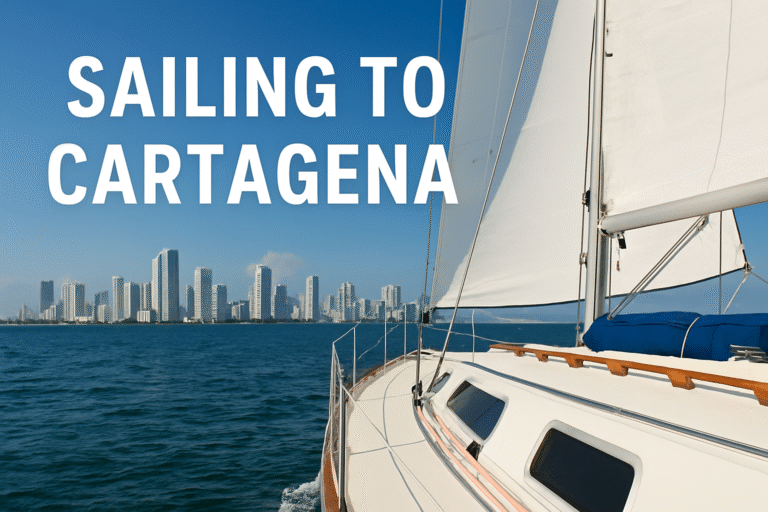Introduction — Why Sail to Cartagena?
Cartagena, Colombia isn’t just a city — it’s a vibrant blend of history, Caribbean culture, colonial charm, and warm tropical waters. While many travelers arrive by plane, those who choose to sail to Cartagena discover a deeper connection to both the journey and the destination. Sailing to this South American port means embracing adventure, freedom, and the kind of slow travel that lets you truly feel the rhythm of the ocean.
Whether you’re chartering a yacht, joining a sailing tour from Panama, or making a stop on a long-distance voyage, arriving in Cartagena by sea is an unforgettable experience — one that’s both scenic and soulful.
Where the Journey Begins — Popular Routes to Cartagena
1. From Panama (San Blas Islands to Cartagena)
The most iconic and well-traveled sailing route to Cartagena begins from Portobelo or Linton Bay, Panama, passing through the San Blas Islands before reaching Colombia.
Highlights:
- 4 to 6-day journey
- Stops at remote islands with pristine beaches
- Encounters with the indigenous Guna Yala people
- Night sailing across the open Caribbean Sea
This route offers both natural beauty and cultural richness — perfect for travelers seeking both connection and seclusion.
2. From the Caribbean Islands
If you’re already island-hopping through the Caribbean, sailing down from Jamaica, the Dominican Republic, or Puerto Rico toward Cartagena makes for a longer but rewarding route.
- Open sea crossing
- Trade winds aiding the sail
- Occasional anchorages along Colombia’s northern coast
This is more suitable for experienced sailors or those joining a seasoned crew.
3. From Central or North America
Longer voyages from the U.S., Mexico, or Belize may also include Cartagena as a major stop. These are often transit legs of global circumnavigations or extended seasonal sailing adventures.
What to Expect on the Journey
The Sea Conditions
Depending on the time of year, sailing to Cartagena can be either calm and breezy or challenging with rougher waters.
- Best months: December to April (dry season)
- Hurricane season caution: June to November, especially if starting from the northern Caribbean
- Currents: Favorable winds often aid southbound voyages
Life Onboard
Whether you’re sailing solo, with a hired captain, or on a group charter, the journey itself is the main event. Expect:
- Cozy cabins and shared space
- Simple meals onboard
- Stargazing on deck
- Sunrise anchorages and beach stops
The simplicity of sailing strips away distractions and reconnects you with nature.
Arrival in Cartagena — First Impressions from the Water
As your boat approaches Cartagena’s bay, the skyline rises with contrasts: modern skyscrapers in Bocagrande, the centuries-old stone walls of the Old Town, and colorful buildings glowing under the Caribbean sun.
You’ll likely anchor in Club Náutico or Club de Pesca, two marinas catering to international sailors.
Immigration and Check-In Process
Colombia is welcoming to sailors, but entry formalities must be followed:
- Hire a local agent to assist with immigration and customs clearance
- Passports and boat documents required
- Typically takes 24–48 hours
- Marina staff usually help coordinate this
Once cleared, you’re free to explore Cartagena — and you’ll find no shortage of things to do.
Exploring Cartagena After the Sail
The Walled City (Ciudad Amurallada)
Step inside a living museum of cobblestone streets, Spanish colonial architecture, plazas, and vibrant colors. Highlights include:
- Plaza Santo Domingo
- San Felipe Castle
- The Clock Tower Gate (Torre del Reloj)
- Street vendors and local cuisine
Wander, get lost, sip fresh juice from street carts, and soak in the rhythm of the city.
Bocagrande and Getsemaní
- Bocagrande: High-rise hotels, shopping malls, and modern restaurants with beach access
- Getsemaní: Bohemian, artsy, and full of murals, street musicians, and local bars
Each neighborhood offers a different view of Cartagena’s culture.
Day Trips and Island Hopping
Your sailing journey doesn’t have to end at port.
- Rosario Islands: Clear waters, snorkeling, and boutique island resorts
- Playa Blanca: Famous white sand beach for day trips
- Volcán del Totumo: A natural mud volcano bath experience
Why Sailing to Cartagena Is More Than a Way to Arrive
1. A Sense of Accomplishment
Sailing across the Caribbean and arriving in a new country by boat adds a layer of adventure and meaning to your travels. It’s not just about getting there — it’s about how you got there.
2. Deep Connection to the Environment
Days at sea remind you how vast and powerful the ocean is. Sailing teaches patience, resilience, and respect for nature.
3. Cultural Immersion Begins Early
By stopping at islands like San Blas, meeting local fishermen at sea, and anchoring at hidden beaches, you’re immersed in authentic experiences long before reaching Cartagena’s port.
Tips for First-Time Sailors to Cartagena
- Pack light but smart: Include waterproof gear, reef-safe sunscreen, motion sickness remedies, and a headlamp
- Be flexible: Weather can shift; sailing is about adapting
- Respect the crew: Whether it’s a private charter or group boat, cooperation keeps the journey smooth
- Bring cash in small denominations for island purchases before reaching Colombia
- Book with trusted operators if not sailing solo — look for strong safety records and crew reviews
Conclusion — Chart Your Course to Cartagena
Sailing to Cartagena is more than a route; it’s a journey of discovery, both personal and geographical. It’s about feeling the wind push you forward, the ocean hum beneath you, and the excitement of spotting land after days at sea.
When your feet finally touch the warm stones of Cartagena’s historic port, you won’t just feel like a tourist — you’ll feel like a traveler who truly earned their arrival.
Whether you’re an experienced sailor or a curious first-timer, sailing to Cartagena is one of the most memorable ways to experience South America’s northern coast.
READ MORE sailing to cartagena
